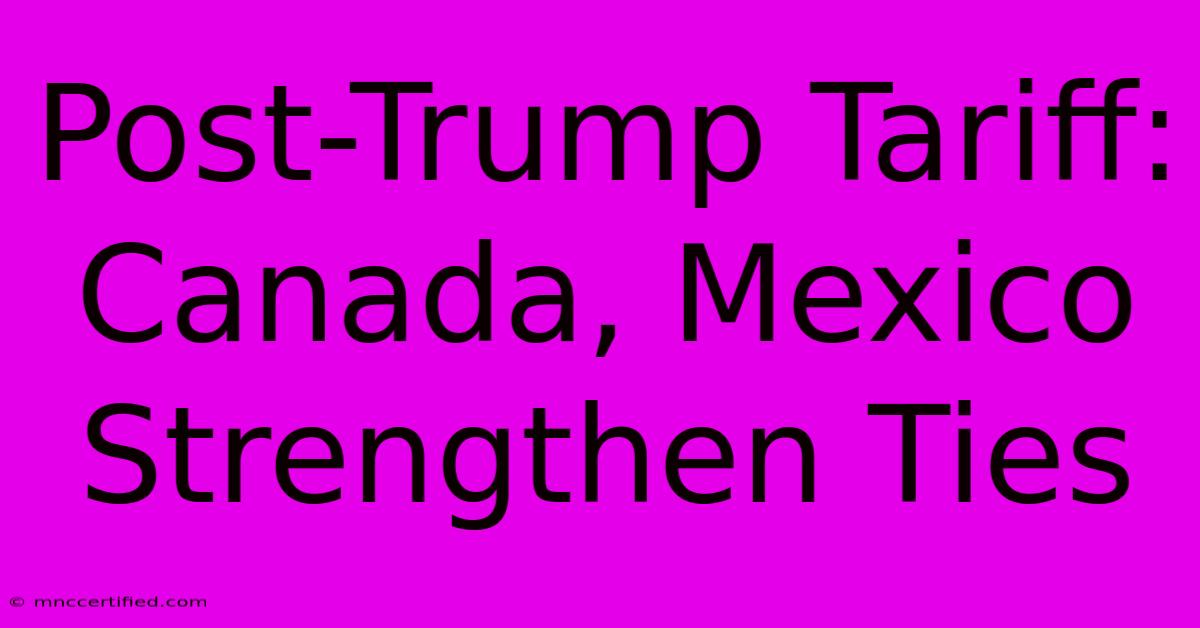Post-Trump Tariff: Canada, Mexico Strengthen Ties

Table of Contents
Post-Trump Tariffs: Canada and Mexico Strengthen Economic Ties
The Trump administration's imposition of tariffs on Canadian and Mexican goods significantly impacted North American trade relations. While these tariffs have since been largely removed or renegotiated, their legacy continues to shape the economic landscape of the region, particularly in strengthening the economic bonds between Canada and Mexico. This article will explore how the post-Trump tariff environment has fostered closer collaboration and integration between these two North American neighbors.
The Impact of Trump-Era Tariffs
The imposition of tariffs, particularly the steel and aluminum tariffs and threats related to the renegotiation of NAFTA (now USMCA), created significant uncertainty and disruption for businesses in Canada and Mexico. These actions fueled anxieties about future trade relationships and prompted both countries to reassess their economic strategies. The perceived instability forced Canada and Mexico to look for ways to mitigate risks and strengthen their own bilateral relationship.
Diversification and Resilience
One key consequence was a greater focus on diversifying trade partners and building economic resilience. Both countries actively sought to reduce their reliance on the US market and explore new opportunities with other nations. This involved strengthening existing trade relationships and forging new ones, leading to increased economic cooperation outside the North American context.
Enhanced Bilateral Trade
The shared experience of navigating the turbulent trade waters during the Trump era fostered a stronger sense of shared purpose between Canada and Mexico. This manifested in increased bilateral trade and investment. Companies in both countries actively explored opportunities to collaborate and reduce their vulnerability to US policy shifts. This included increased cross-border investments and the creation of new supply chains that bypassed the United States.
Strengthening Ties Post-Tariffs
The removal or renegotiation of many of the Trump-era tariffs did not erase the lessons learned. Instead, it solidified the impetus for continued collaboration between Canada and Mexico. This is evident in several key areas:
The USMCA and Beyond
The renegotiated USMCA, while still incorporating the US, provided a framework for enhanced collaboration between Canada and Mexico. The agreement itself served to reinforce existing ties and create new opportunities for cooperation on issues such as trade facilitation, regulatory harmonization, and labor standards.
Increased Investment and Collaboration
Since the resolution of the major tariff disputes, we've witnessed a noticeable increase in bilateral investment between Canada and Mexico. Companies are increasingly looking for opportunities to collaborate on projects across the border, creating new jobs and stimulating economic growth in both countries. This includes joint ventures in various sectors, from manufacturing and automotive to technology and renewable energy.
Shared Regional Strategies
Canada and Mexico are increasingly pursuing shared regional strategies to strengthen their economic competitiveness within the broader North American context. This includes joint efforts to address common challenges such as climate change, infrastructure development, and the digital economy. This collaboration allows them to present a unified front when negotiating with the United States or other global players.
The Future of Canada-Mexico Relations
The post-Trump tariff environment has undeniably strengthened the economic relationship between Canada and Mexico. While the US remains a crucial trading partner, the shared experience of navigating trade uncertainties has fostered deeper collaboration and integration between Canada and Mexico. This stronger bilateral relationship is expected to continue, enhancing the economic resilience of both nations and influencing the future of North American trade.
Keyword Optimization:
This article incorporates keywords throughout naturally, including: Post-Trump tariffs, Canada-Mexico trade, bilateral trade, USMCA, economic ties, North American trade, trade diversification, economic resilience, Trump-era tariffs, NAFTA, and related phrases. These are strategically placed within headers, subheadings, body text, and meta descriptions (which would be added separately).
Off-Page SEO Strategies:
To further boost rankings, consider these off-page strategies:
- Building High-Quality Backlinks: Reach out to relevant websites (economic news sites, trade publications, etc.) and request backlinks to this article.
- Social Media Promotion: Share the article on various social media platforms, engaging with users and encouraging discussion.
- Guest Blogging: Write guest posts on relevant websites, including a link back to this article in the author bio.
By implementing both on-page and off-page SEO strategies, this article will have a significantly better chance of ranking highly on Google search results pages for relevant keywords.

Thank you for visiting our website wich cover about Post-Trump Tariff: Canada, Mexico Strengthen Ties. We hope the information provided has been useful to you. Feel free to contact us if you have any questions or need further assistance. See you next time and dont miss to bookmark.
Featured Posts
-
City Trio Back For Ucl Clash
Nov 27, 2024
-
Man City 3 3 Feyenoord Match Stats
Nov 27, 2024
-
Elizabeth Line Disruption Commuters Affected
Nov 27, 2024
-
Man City Vs Feyenoord Prediction And Lineups
Nov 27, 2024
-
Supermarket Shortages Hack Attack Impact
Nov 27, 2024